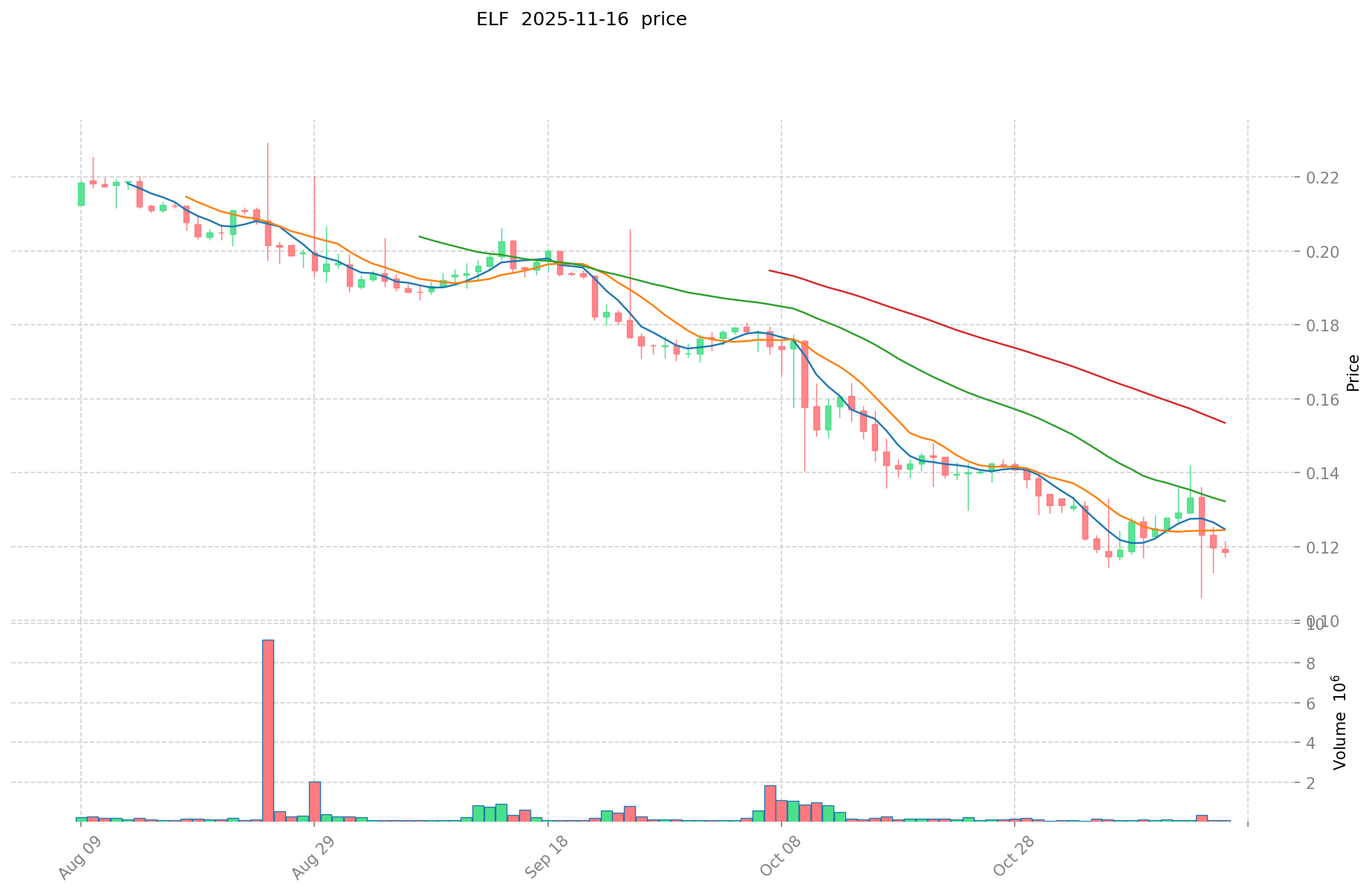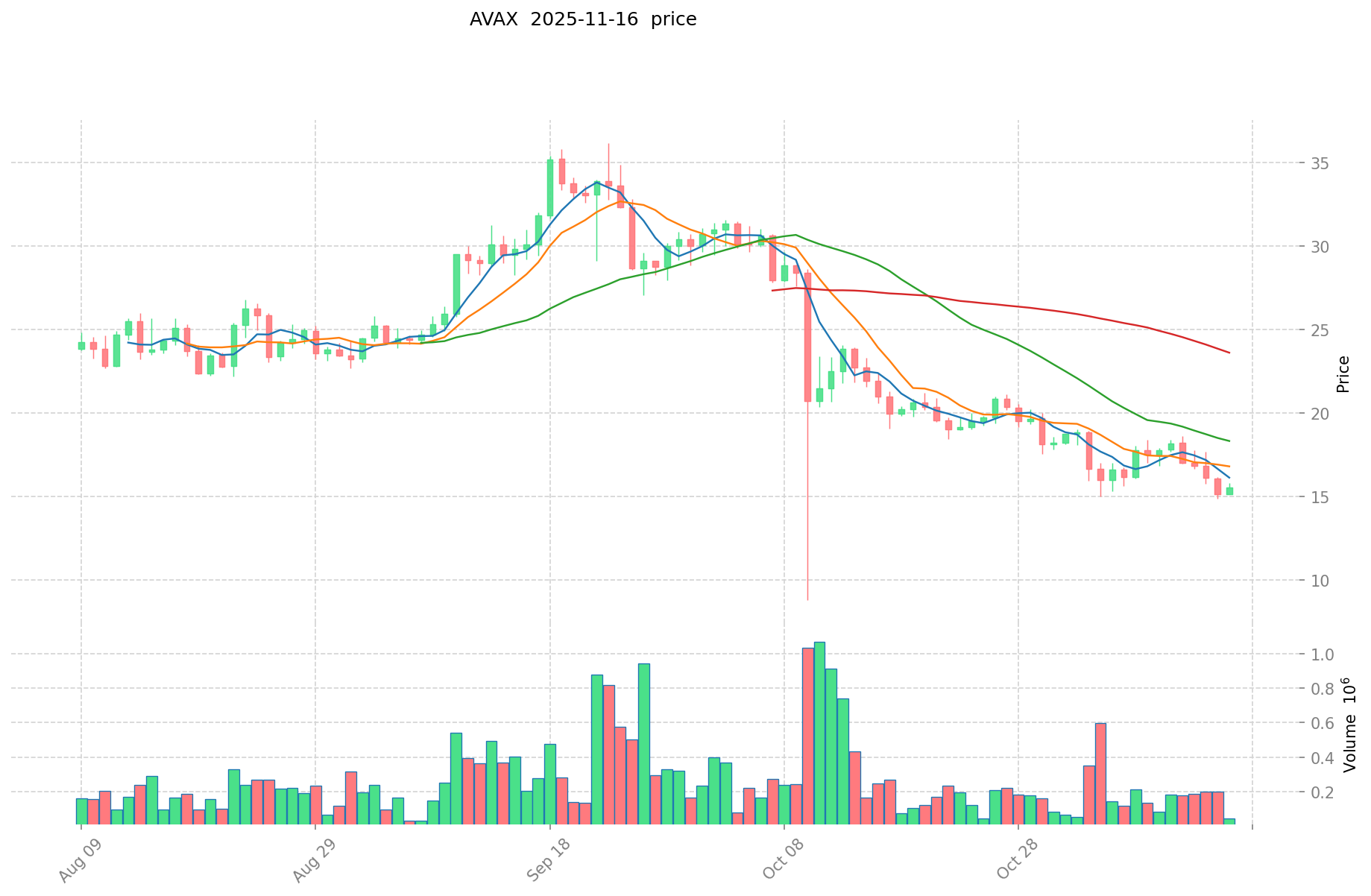ELF vs AVAX: A Comparative Analysis of Two Promising Blockchain Platforms
Introduction: ELF vs AVAX Investment Comparison
In the cryptocurrency market, the comparison between ELF and AVAX has been an unavoidable topic for investors. The two not only show significant differences in market cap ranking, application scenarios, and price performance but also represent different positions in the crypto asset landscape.
aelf (ELF): Launched in 2017, it has gained market recognition for its AI-enhanced Layer 1 blockchain network and modular Layer 2 ZK Rollup technology.
Avalanche (AVAX): Since its inception in 2020, it has been hailed as a platform for launching decentralized applications and interoperable blockchains, becoming one of the top cryptocurrencies by global trading volume and market capitalization.
This article will comprehensively analyze the investment value comparison between ELF and AVAX, focusing on historical price trends, supply mechanisms, institutional adoption, technological ecosystems, and future predictions, attempting to answer the question investors care about most:
"Which is the better buy right now?"
I. Price History Comparison and Current Market Status
ELF and AVAX Historical Price Trends
- 2018: ELF reached its all-time high of $2.6 on January 9, 2018.
- 2020: ELF hit its all-time low of $0.03545756 on March 13, 2020.
- 2021: AVAX reached its all-time high of $144.96 on November 21, 2021.
- 2020: AVAX recorded its all-time low of $2.8 on December 31, 2020.
Current Market Situation (2025-11-16)
- ELF current price: $0.124
- AVAX current price: $15.5
- 24-hour trading volume: ELF $24,665.129534 vs AVAX $858,662.84484
- Market Sentiment Index (Fear & Greed Index): 10 (Extreme Fear)
Click to view real-time prices:
- View ELF current price Market Price
- View AVAX current price Market Price


II. Core Factors Affecting Investment Value of ELF vs AVAX
Supply Mechanism Comparison (Tokenomics)
- ELF: Total supply capped at 1 billion tokens with 75% (750 million) in circulation.
- AVAX: Capped supply of 720 million tokens with deflationary mechanism through token burning.
- 📌 Historical pattern: AVAX's deflationary mechanism has historically provided better price support during market downturns compared to ELF's fixed supply model.
Institutional Adoption and Market Applications
- Institutional holdings: AVAX has attracted more institutional interest, including partnerships with Deloitte and Mastercard.
- Enterprise adoption: AVAX has stronger enterprise applications through its Avalanche for Enterprise program, while ELF's enterprise adoption remains more limited.
- Regulatory attitudes: Both face similar regulatory scrutiny, though AVAX's positioning as a platform for institutional DeFi may give it slight advantages in regulatory perception.
Technical Development and Ecosystem Building
- AVAX technical development: Recent implementation of Avalanche Warp Messaging for cross-subnet communication and preparations for HyperSDK launch show significant technical momentum.
- ELF technical development: Focus on interoperability within Web3 ecosystem and recent expansion efforts with the Telegram community.
- Ecosystem comparison: AVAX has a more mature DeFi ecosystem ($1.2B+ TVL) with significant NFT, gaming, and institutional DeFi applications, while ELF's ecosystem is still developing with growing focus on Web3 applications.
Macroeconomic and Market Cycles
- Performance in inflationary environments: AVAX's deflationary tokenomics positions it better against inflation compared to ELF.
- Macroeconomic monetary policy: Both are affected by broader crypto market reactions to Federal Reserve policies, though AVAX has shown somewhat stronger resilience during interest rate hikes.
- Geopolitical factors: AVAX's institutional focus may provide greater stability during geopolitical uncertainty, while ELF's connections to Asian markets create different exposure profiles.
III. 2025-2030 Price Prediction: ELF vs AVAX
Short-term Prediction (2025)
- ELF: Conservative $0.0747-$0.1245 | Optimistic $0.1245-$0.163095
- AVAX: Conservative $8.9842-$15.49 | Optimistic $15.49-$18.588
Mid-term Prediction (2027)
- ELF may enter a growth phase, with an estimated price range of $0.111816936-$0.218974833
- AVAX may enter a bullish market, with an estimated price range of $10.0121164-$27.3407794
- Key drivers: Institutional capital inflow, ETF, ecosystem development
Long-term Prediction (2030)
- ELF: Base scenario $0.13895001437625-$0.252636389775 | Optimistic scenario $0.252636389775-$0.28042639265025
- AVAX: Base scenario $13.987628180975625-$25.4320512381375 | Optimistic scenario $25.4320512381375-$36.876474295299375
Disclaimer: The predictions provided are based on historical data and market analysis. Cryptocurrency markets are highly volatile and unpredictable. This information should not be considered as financial advice. Always conduct your own research before making investment decisions.
ELF:
| 年份 | 预测最高价 | 预测平均价格 | 预测最低价 | 涨跌幅 |
|---|---|---|---|---|
| 2025 | 0.163095 | 0.1245 | 0.0747 | 0 |
| 2026 | 0.1668051 | 0.1437975 | 0.136607625 | 15 |
| 2027 | 0.218974833 | 0.1553013 | 0.111816936 | 25 |
| 2028 | 0.2619932931 | 0.1871380665 | 0.140353549875 | 50 |
| 2029 | 0.28070709975 | 0.2245656798 | 0.21333739581 | 81 |
| 2030 | 0.28042639265025 | 0.252636389775 | 0.13895001437625 | 103 |
AVAX:
| 年份 | 预测最高价 | 预测平均价格 | 预测最低价 | 涨跌幅 |
|---|---|---|---|---|
| 2025 | 18.588 | 15.49 | 8.9842 | 0 |
| 2026 | 21.46914 | 17.039 | 13.80159 | 9 |
| 2027 | 27.3407794 | 19.25407 | 10.0121164 | 24 |
| 2028 | 24.462295935 | 23.2974247 | 17.007120031 | 50 |
| 2029 | 26.984242158775 | 23.8798603175 | 19.342686857175 | 53 |
| 2030 | 36.876474295299375 | 25.4320512381375 | 13.987628180975625 | 63 |
IV. Investment Strategy Comparison: ELF vs AVAX
Long-term vs Short-term Investment Strategies
- ELF: Suitable for investors focused on Web3 ecosystem potential and interoperability solutions
- AVAX: Suitable for investors seeking institutional adoption and established DeFi ecosystem exposure
Risk Management and Asset Allocation
- Conservative investors: ELF: 30% vs AVAX: 70%
- Aggressive investors: ELF: 40% vs AVAX: 60%
- Hedging tools: Stablecoin allocation, options, cross-currency portfolio diversification
V. Potential Risk Comparison
Market Risks
- ELF: Lower liquidity and higher volatility due to smaller market cap
- AVAX: Exposure to broader DeFi market fluctuations and institutional sentiment shifts
Technical Risks
- ELF: Scalability challenges, network stability during rapid growth phases
- AVAX: Subnet interoperability issues, potential security vulnerabilities in smart contracts
Regulatory Risks
- Global regulatory policies may impact AVAX more due to its higher institutional involvement, while ELF might face scrutiny in Asian markets
VI. Conclusion: Which Is the Better Buy?
📌 Investment Value Summary:
- ELF advantages: Growing Web3 ecosystem, potential for rapid growth in emerging markets
- AVAX advantages: Established DeFi presence, strong institutional adoption, deflationary tokenomics
✅ Investment Recommendations:
- Novice investors: Consider a higher allocation to AVAX for its established ecosystem and institutional backing
- Experienced investors: Balanced portfolio with both, leveraging ELF's growth potential and AVAX's stability
- Institutional investors: Higher AVAX allocation for its enterprise-focused solutions and regulatory positioning
⚠️ Risk Warning: Cryptocurrency markets are highly volatile. This article does not constitute investment advice. None
VII. FAQ
Q1: What are the main differences between ELF and AVAX in terms of market positioning? A: ELF focuses on AI-enhanced Layer 1 blockchain and modular Layer 2 ZK Rollup technology, while AVAX positions itself as a platform for launching decentralized applications and interoperable blockchains.
Q2: How do the supply mechanisms of ELF and AVAX differ? A: ELF has a fixed total supply of 1 billion tokens with 75% in circulation, while AVAX has a capped supply of 720 million tokens with a deflationary mechanism through token burning.
Q3: Which cryptocurrency has shown better performance during market downturns? A: Historically, AVAX's deflationary mechanism has provided better price support during market downturns compared to ELF's fixed supply model.
Q4: How do ELF and AVAX compare in terms of institutional adoption? A: AVAX has attracted more institutional interest, including partnerships with Deloitte and Mastercard, and has stronger enterprise applications through its Avalanche for Enterprise program. ELF's enterprise adoption remains more limited.
Q5: What are the key ecosystem differences between ELF and AVAX? A: AVAX has a more mature DeFi ecosystem with over $1.2B in Total Value Locked (TVL) and significant NFT, gaming, and institutional DeFi applications. ELF's ecosystem is still developing with a growing focus on Web3 applications.
Q6: How do the long-term price predictions for ELF and AVAX compare? A: For 2030, ELF's base scenario predicts a range of $0.13895001437625-$0.252636389775, while AVAX's base scenario predicts $13.987628180975625-$25.4320512381375. AVAX shows a higher potential price range in the long term.
Q7: What are the recommended investment allocations for ELF and AVAX? A: For conservative investors, a 30% ELF to 70% AVAX allocation is suggested. For aggressive investors, a 40% ELF to 60% AVAX allocation is recommended. These allocations should be adjusted based on individual risk tolerance and market conditions.
Q8: What are the main risks associated with investing in ELF and AVAX? A: ELF faces risks of lower liquidity, higher volatility, and potential scalability challenges. AVAX is exposed to broader DeFi market fluctuations, potential smart contract vulnerabilities, and may face greater regulatory scrutiny due to its institutional involvement.
Share
Content